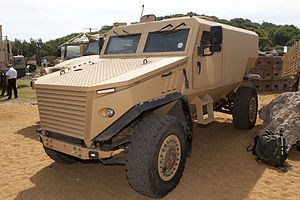Ocelot (vehicle)
| Force Protection Ocelot LPPV | |
|---|---|
 |
|
| Type | Armoured car |
| Place of origin | United Kingdom |
| Production history | |
| Designer | Ricardo plc / Force Protection Europe |
| Designed | 2009–2010 |
| Manufacturer | Force Protection Europe |
| Unit cost | £923k (~US$1.5m) |
| Produced | 2011– (projected) |
| Variants | Prototypes in differing configurations including LRPV and steel armour |
| Specifications | |
| Weight | up to 7,500 kg (7.4 long tons) |
| Length | 5.32 m (17 ft 5 in) |
| Width | 2.1 m (6 ft 11 in) |
| Height | 2.35 m (7 ft 9 in) |
|
|
|
| Speed | 132 km/h (82 mph) |
The Force Protection Ocelot is a British armoured vehicle that is scheduled to replace the United Kingdom's Snatch Land Rover with British forces. It will receive the service name Foxhound, in line with the names given to other wheeled armored vehicles in current British use, such as Mastiff and Ridgeback, which are based on the Cougar. This is not to be confused with the BAE Systems Australia Foxhound, a modified Short Brothers S600. The goal in replacing the Snatch Land Rover was to improve protection of personnel against improvised explosive devices (IEDs).
Designed by Force Protection Europe and the automotive engineering company Ricardo, the Ocelot is intended for use as a light protected patrol vehicle (LPPV) with specialised protection against roadside bombs and improvised explosive devices (IED)s. It can weigh up to 7,500 kilograms (16,500 lb) when loaded. This is smaller than most Mine-Resistant Ambush-Protected (MRAP) vehicles, but larger than the Humvee replacement vehicles being developed through the Joint Light Tactical Vehicle (JLTV) program.
Powered by a Steyr M16-Monoblock Diesel engine (6-cylinder, 160 kW), connected to a ZF 6HP28X 6-speed automatic transmission, it reaches a speed of 50 mph (80 km/h) in 19.75 seconds, and has a maximum speed of 82 mph (132 km/h). Its wheels function independently, so the vehicle's other wheels should continue to work if one is blown off. It is claimed that the engine can be removed and replaced in 30 minutes.
The design is modular, and all of the components can be removed easily. The protective pod where up to six people can sit is interchangeable to allow easy modification according to the vehicle's role. For example, it can perform as an ambulance, supply vehicle, or jeep. Parts can also be easily replaced for minimum service time. It can travel through terrain that would not be accessible to other civilian vehicles, such as jungle, deep mud, or ruts. Its cabin is made of advanced composite materials. It is claimed that such composite materials can provide protection like metal armor with a composite spall liner, but at a lighter weight, saving fuel. Critical parts such as the crew compartment, engine, fuel tank and transmission are contained within the V-shaped armored ‘spine’ that deflects potential blast away from the pod, thus protecting the occupants and key components.
...
Wikipedia
